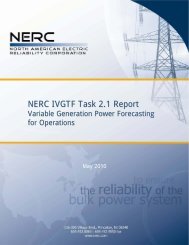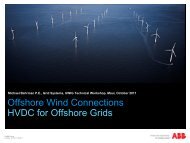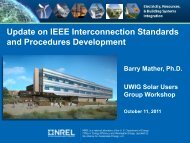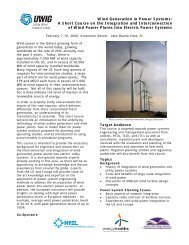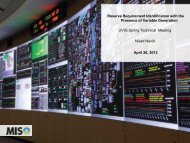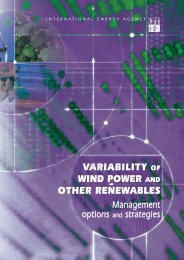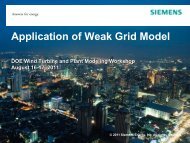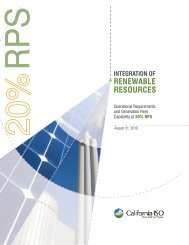MISO Energy Storage Study Phase 1 Report - Utility Wind ...
MISO Energy Storage Study Phase 1 Report - Utility Wind ...
MISO Energy Storage Study Phase 1 Report - Utility Wind ...
Create successful ePaper yourself
Turn your PDF publications into a flip-book with our unique Google optimized e-Paper software.
THE <strong>MISO</strong> PLANNING ENVIRONMENT<br />
reserves in the day ahead and real time markets in addition to bidding resources for energy<br />
dispatch. In <strong>MISO</strong> day ahead and real time energy markets, prices are cleared at the intersection<br />
of supply and demand based on the marginal cost for the last generation unit required. In the<br />
same way, ASM’s clear prices at a zonal or system wide level based on reliability and<br />
contingency requirements in each zone. By making ancillary services subject to market forces,<br />
<strong>MISO</strong> encourages market participants to provide adequate services to ensure reliability in a cost<br />
effective manner. Operations planning timeframes dictate the resources needed (see Figure 2-2).<br />
The following ancillary services are observed in <strong>MISO</strong>:<br />
• Regulation: automated second by second system balancing<br />
• Frequency Regulation: maintains the power system frequency within a predetermined<br />
range. This service requires the unit to be very flexible at short notice. Ranges from<br />
inertial response that may be 1-2 seconds following a frequency disturbance, to primary<br />
frequency response (5-10 seconds) and regulation (10 seconds to several minutes).<br />
Mostly implemented by automated generator control (AGC).<br />
• VAR (Volts-Amp-Reactive): maintains the electrical transmission system power factor<br />
at a level close to 1.0, reducing losses.<br />
• Contingency: energy supply available at short notice to meet unexpected system changes<br />
• Spinning reserve: provides contingency generation that can be switched into use<br />
immediately in order to respond to a system outage or sudden power loss. Spinning<br />
reserves are designated synchronous if they are in sync with the transmission system (and<br />
can be called upon more quickly) or non-synchronous. Sufficient reserves are required to<br />
counter an “N-1” contingency meaning the largest expected unit outage from a system<br />
failure. Supplemental spinning reserves are 10-minute start – meaning that they can be<br />
dispatched in 10 minutes.<br />
• Ramping: provides rapid ramping power (up ramp and down ramp) when demand<br />
increases or decreases at a high rate (minutes to hours). Ramping is also referred to as<br />
load following (see Figure 2-2). It is typically used during the shoulder hours either side<br />
of the peak daily load. The <strong>MISO</strong> tariff does not fully recognize ramping resource value<br />
although a separate <strong>MISO</strong> study group is analyzing the issue.<br />
Ancillary services are an important component in estimating the benefits that energy storage<br />
provides. Because energy storage can be switched on and off quickly, it is an attractive resource<br />
for contingency and regulation. Where storage technology is less flexible, (e.g. when a pumped<br />
storage system changes from pumping mode to storage mode it may take several minutes to<br />
respond), then ancillary benefits are lower. For storage technologies such as batteries that only<br />
have short-term power, the current cost is hard to justify without including ancillary benefits.<br />
One ancillary service that energy storage could potentially provide in <strong>MISO</strong> is ramping. A<br />
separate <strong>MISO</strong> study is reviewing the existing ramp resource Tariff treatment and this initiative<br />
is explained in more detail in Chapter 4. RPS mandated variable generation and coal plant<br />
retirement because of EPA regulation increase the ramping requirements on natural gas fired<br />
generation. The result is that CC and CT units will be cycled more frequently than they were<br />
designed to be. As a result, there is good potential benefit in using energy storage for ramp<br />
services to reduce this cycling.<br />
2-3




